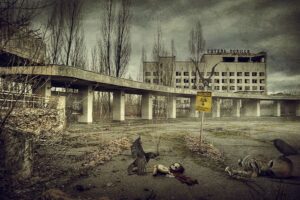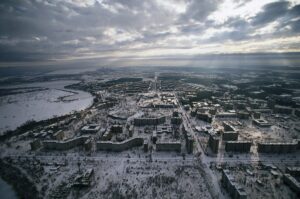In the heart of Ukraine lies a place frozen in time, where the echoes of past life linger amongst overgrown streets and decaying buildings. Pripyat, once a bustling city near the Chernobyl Nuclear Power Plant, now stands as a ghost town, forever marked by the devastating events that unfolded on April 26, 1986. This article delves into the haunting legacy of Pripyat, exploring the dramatic evacuation after the nuclear disaster and the lasting impact it continues to have on the surrounding area.


A City Born from the Promise of Progress:
Pripyat, established in 1970, was specifically built to accommodate the workers of the nearby Chernobyl Nuclear Power Plant. Its purpose was to serve as a vibrant city, fostering a sense of community for those involved in the plant’s operations. With its modern architecture, cultural venues, and abundant greenery, Pripyat embodied the vision of a utopian city.
The Unthinkable Disaster:
The Chernobyl disaster, which occurred on April 26, 1986, forever altered the course of Pripyat’s history. During a routine safety test, one of the reactors experienced a catastrophic explosion, resulting in the release of a deadly radioactive cloud. This unprecedented event quickly turned Pripyat into a perilous place, and its 49,000 residents were evacuated within days.
Evacuation Process and Legacy:
The evacuation of Pripyat was swift and chaotic. Residents were told that they would be returning within a few days, leading many to leave behind cherished possessions and personal belongings. Unfortunately, these unfulfilled promises meant that the evacuation was permanent for most residents, as the area surrounding the Chernobyl plant became uninhabitable due to the elevated radiation levels.
The Haunting Atmosphere of Pripyat:
Today, Pripyat stands as a chilling testament to human abandonment. The eerie silence is only interrupted by the sounds of wind rustling through crumbling buildings and nature reclaiming its territory. The empty amusement park, frozen Ferris wheel, and abandoned school halls all contribute to the surreal atmosphere that pervades the ghost town.
Radiation and Wildlife:
Despite the dangers posed by radiation, nature has shown remarkable resilience in slowly reclaiming the area surrounding Pripyat. The absence of human interference has allowed wildlife to flourish, with many species thriving and adapting to this unique environment. Researchers continue to study the long-term effects of radiation on both flora and fauna, providing valuable insights into the consequences of nuclear disasters.
Contemporary Interest and Tourism:
In recent years, there has been a surge in interest from tourists seeking to explore the haunting beauty and history of Pripyat. Guided tours offer a chance to witness firsthand the abandoned buildings, schools, hospitals, and the infamous Chernobyl power plant itself. However, visitors must adhere to strict safety protocols to prevent exposure to lingering radiation.
Lessons Learned and the Significance of Pripyat:
The catastrophic events that unfolded in Pripyat have left an indelible mark on the collective consciousness of humankind. It serves as a poignant reminder of the importance of strict safety regulations and procedures when operating nuclear facilities. Additionally, the ghost town of Pripyat serves as a symbol of the potential consequences of technological disasters, highlighting the need to prioritize the well-being of both people and the environment.
Conclusion:
Pripyat, the ghost town near the Chernobyl Nuclear Power Plant, stands as a chilling reminder of one of the world’s worst technological disasters. Its tragic story continues to captivate the world, drawing visitors to witness the haunting legacy left by the nuclear catastrophe. As we explore the deserted streets and crumbling buildings, we are reminded of the fragility of our technological endeavors and the imperative to prioritize safety at all costs.

